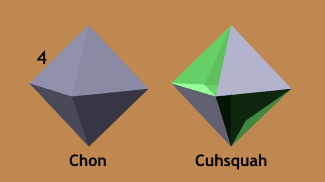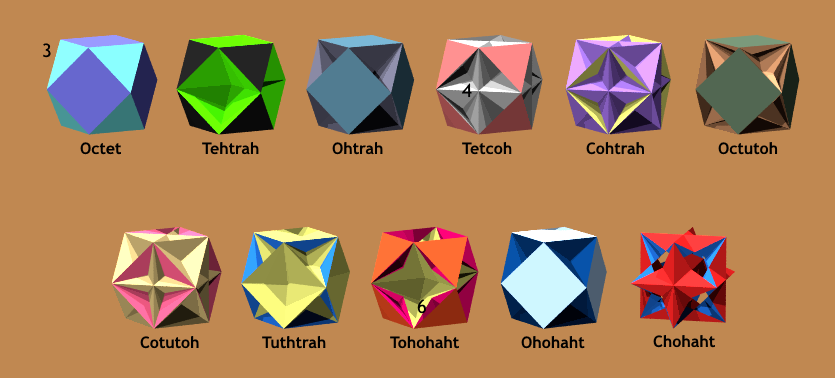
The primary honeycombs are single-node wythoffians whose vertex figures have nonprismatic symmetry. This comes out to chon, the cubic honeycomb, our one and only regular honeycomb, and its regiment member under demicubic, as well as octet, the demicubic honeycomb, and its regiment under full and cyclotettic symmetry. Octet is the first demicubic tesselation! These will continue to exist.

1. Chon - Cubic honeycomb. Cells are cubes. Its verf is an oct. Symbols are x4o3o4o, x4o3o *b3o, x4o3o4x, and perhaps some other things. This is our 3-D hypercubic honeycomb! It can be considered a stack of square tiling prisms, it is the apeirogon triocomb and apeirogon x square tiling duocomb. It's self dual, like all hypercubic honeycombs. I call chon's symmetry "chonnic".
2. Cuhsquah - Cubihemisquare honeycomb. Cells are cubes and squats. Its verf is a thah. This is analogous to tho, also can be considered the 3-D version of sha. It can be considered an alternating stack of gyrating sha prisms, if you wanted to. Members of hypercubic honeycombs with demicubic symmetry and demicross vertex figures with hypercubes and hypercubic honeycomb facets continue to exist in all dimensions. I don't think this family has a name, like the one we have for "demicross". I suggest "hemihypercubic honeycomb", because demihypercubic honeycomb is taken and they have hemifacets. This has the same symmetry as octet.

3. Octet - Tetrahedral-octahedral honeycomb. Cells are tets and octs. Verf is a co. Symbols are o3o4x *b3o and o3o3o3x3*a. This is our first demihypercubic honeycomb! It also overlaps with the cyclosimplex honeycomb family, which will separate out in 4-D. I call its symmetry "octettic". Its subsymmetry as a cyclosimplex honeycomb is called "cyclotettic". There are also lots of odd atypical subsymmetries here we'll be seeing later.
4. Tehtrah - Tetrahemitriangular honeycomb. Cells are tets and trats. Verf is an oho. Symbol is o3x3o3o3/2*a3*c. This one is only wythoffian under cyclotettic, as oho is only wythoffian under tetrahedral. This was known as Datha long ago, before the name was taken over by a C7 member.
5. Ohtrah - Octahemitriangular honeycomb. Cells are octs and trats. Verf is a cho. Tehtrah and ohtrah are edge transitive with uniform verfs, and thus accept truncation and rectification, which we will see later.
6. Tetcoh - Tetrahedral-cuboctahedral honeycomb. Cells are tets and coes.
7. Cohtrah - Cuboctahedral-hemitriangular honeycomb. Cells are coes and trats.
8. Octutoh - Octahedral-tomotetrahedral honeycomb. Cells are octs and tuts.
9. Cotutoh - Cuboctahedral-tomotetrahedral honeycomb. Cells are coes and tuts. Prreviously known as Tutcoh.
10. Tuthtrah - Tomotetrahedral-hemitriangular honeycomb. Cells are tuts and trats.
11. Tohohaht - Tetrahedral-octahemioctahedral-hemihexagonal honeycomb. Cells are tets, ohoes, and fexats. Remember fexat? It's the regular compound of three hexats in the trat regiment. It plays a similar role to rhom from the uniform polychora.
12. Ohohaht - Octahedral-octahemioctahedral-hemihexagonal honeycomb. Cells are octs, ohoes, and fexats. The fexats are completely hidden in the interior of this one.
13. Chohaht - Cubohemioctahedral-hemihexagonal honeycomb. Cells are choes and fexats. This one is hollow, but only because of filling method. The hexats in fexat form +/- density pairs and overlap into nothing. This would happen in ohohaht too... if you could see the fexats.

These sorta behave similarly to the gadtaxady regiment from the uniform polychora, but the doubled symmetry and extra facets gives it a lot of differences. It's probably best to treat these as their own unique entity. On Eric's old website, tuts were placed before coes, and thahs were placed even after ohoes, so I've reordered the morphemes in the names in order to better reflect a natural order. The BSAs are changed accordingly, making basically this whole category look different. Soz.
14. Datteha - Ditetrahedronary tetrahemiapeiratic honeycomb. Cells are tets and ditathas. Verf is a semiuniform antitruncated tetrahedron. Symbol is o3o3/2x∞o3*b. It can be seen as the 3-D version of ditatha, and continued dimensional analogues for ditatha will exist in cyclosimplex honeycombs.
15. Dattoha - Ditetrahedronary tetraoctahemiapeiratic honeycomb. Cells are tets, octs, and ditathas.
16. Datetcoha - Ditetrahedronary tetracuboctahemiapeiratic honeycomb. Cells are tets, coes, and ditathas.
17. Dattetuthah - Ditetrahedronary tetratomotetrahemihexagonal honeycomb. Cells are tets, tuts, and fexats.
18. Dattotuthah - Ditetrahedronary tetraoctatomotetrahemihexagonal honeycomb. Cells are tets, octs, tuts, and fexats.
19. Datet Cotuthah - Ditetrahedronary tetracuboctatomotetrahemihexagonal honeycomb. Cells are tets, coes, tuts, and fexats. The fexats are completely hidden in the interior of this one.
20. Datethotuth - Ditetrahedronary tetrahemioctatomotetrahedral honeycomb. Cells are tets, ohoes, and tuts.
21. Radtethotuth - Retroditetrahedronary tetrahemioctatomotetrahedral honeycomb. Cells are tets, choes, and tuts. This one is hollow, and not just because of filling, it's like really hollow.
22. Datetho Tuthath- Ditetrahedronary tetrahemioctatomotetrahemitriangular honeycomb. Cells are tets, choes, tuts, and trats.
23. Dattohotuth - Ditetrahedronary tetraoctahemioctatomotetrahedral honeycomb. Cells are tets, octs, choes, and tuts.
24. Datohotutha - Ditetrahedronary octahemioctatomotetrahemiapeiratic honeycomb. Cells are octs, choes, tuts, and ditathas.
25. Dathotutha - Ditetrahedronary hemioctatomotetrahemiapeiratic honeycomb. Cells are ohoes, tuts, and ditathas.
26. Radthotutha - Retroditetrahedronary hemioctatomotetrahemiapeiratic honeycomb. Cells are choes, tuts, and ditathas. This one has a tunneled appearance, as it has a similar verf to radtethotuth but the hollow space gets partially crossed by ditathas.
27. Datethahsh - Ditetrahedronary tetrahemihexahemisquare honeycomb. Cells are tets, thahs, and squats. This is alternated cuhsquah! The octet members below this point will contain thahs and squats, which makes these members not have analogues in the polychoron ditetrahedrals.
28. Dateth Hehthash - Ditetrahedronary tetrahemihexahemitriangularhemisquare honeycomb. Cells are tets, thahs, trats, and squats.
29. Datha Hehasha - Ditetrahedronary hemihexahemisquarehemiapeiratic honeycomb. Cells are thahs, ditathas, and squats.
30. Dateth Hehohahehash - Ditetrahedronary tetrahemihexahemioctahemihexagonalhemisquare honeycomb. Cells are tets, thahs, ohoes, fexats, and squats.
31. Datha Hehotuthash - Ditetrahedronary hemihexahemioctatomotetrahemisquare honeycomb. Cells are thahs, ohoes, tuts, and squats.
32. Datha Hetuthahehash - Ditetrahedronary hemihexatomotetrahemihexagonalhemisquare honeycomb. Cells are thahs, tuts, fexats, and squats.

These are the members of the octet regiment (with these symmetries) that are compound or fissary. The compounds are octettic, the fissaries are cyclotettic. None of the fissaries are vertex fissary, only edge fissaries here.
C. Focoh - Fissal octahedral-cuboctahedral honeycomb. Cells are octs and coes. This is a compound of 4 riches from C3, the vertex figure is a semiuniform rah. Externally, it looks identical to ohohaht, as the differences between the two are hidden beneath the octs.
C. Fitetuth - Fissal tetrahedral-tomotetrahedral honeycomb. Cells are tets and tuts. This is a compound of 8 cytatohs from C7, the vertex figure is a sno variant.
C. Fituoh - Fissal tomooctahedral honeycomb. Cells are toes. This is a compound of 16 batches from C2, the vertex figure is a snu variant. Noble!
F. Fidtet Ditutha- Fissary ditetrahedronary tetradistomotetrahemiapeiratic honeycomb. Cells are tets, tuts in two orbits, and ditathas.
F. Fidtet Hahedtuthash - Fissary ditetrahedronary tetrahemihexadistomotetrahemisquare honeycomb. Cells are tets, thahs, tuts in two orbits, and squats. This one and the one below it were previously mislabeled as legit uniforms by older sources.
F. Fidatha Hedtuthahash - Fissary ditetrahedronary hemihexadistomotetrahemiapeiratihemisquare honeycomb. Cells are thahs, tuts in two orbits, ditathas, and squats.
The following honeycombs are self conjugate: all.
The following form conjugate pairs: none.
Category B --- Back to Honeycombs Home --- Category 2
Site by ThePokemonkey123, based on the work of Eric Binnendyk
contact me on discord you don't get my email
Images by creeperman7002 using POV-Ray. What a cool guy! Everyone please compliment their work.